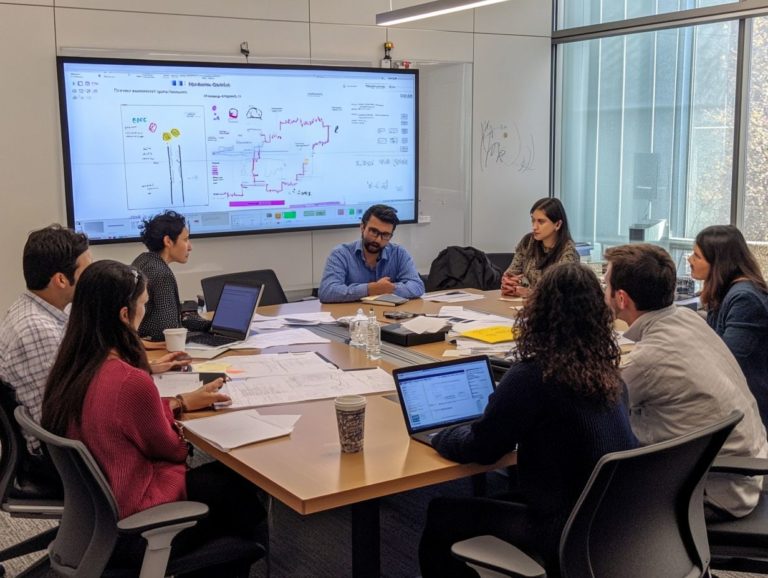challenges in incident response planning
In today’s digital landscape, your ability to effectively respond to incidents is paramount for your organization.
Incident Response Planning (IRP) acts as your strategic roadmap for addressing security breaches and other emergencies. This ensures your teams can take swift and effective action when it matters most. Crafting a strong plan presents challenges, from pinpointing vulnerabilities to coordinating responses seamlessly.
This article delves into the common obstacles organizations encounter in IRP. It provides practical strategies to overcome these challenges and underscores the importance of a proactive approach to safeguarding sensitive information.
Explore the future of incident response with us. We uncover emerging technologies and best practices designed to enhance your preparedness and resilience.
Contents
- Key Takeaways:
- Overview of Incident Response Planning
- Common Challenges in Incident Response Planning
- Effective Strategies for Overcoming Challenges
- Importance of Incident Response Planning
- Future of Incident Response Planning
- Frequently Asked Questions
- What are the main challenges in incident response planning?
- How does inadequate training affect incident response planning?
- What role does the limited budget play in incident response planning?
- How does the changing threat landscape affect incident response planning?
- What impact does lack of communication have on incident response planning?
- How can organizations overcome these challenges in incident response planning?
Key Takeaways:

- Identifying and addressing vulnerabilities is crucial for effective incident response planning.
- Regular training and testing are essential for overcoming communication and coordination challenges.
- An effective incident response plan minimizes damage, downtime, and protects sensitive information.
Overview of Incident Response Planning
Incident response planning is an essential element of cybersecurity. It enables you to prepare for, respond to, and recover from a range of cybersecurity incidents.
This involves a structured approach to incident management. It ensures that effective measures are in place to counter potential cyber threats.
By establishing a strong incident response plan, you enhance your security posture and minimize the impact of data breaches. This proactive strategy protects your organization and fosters continuous improvement in your incident response capabilities.
What is Incident Response Planning?
Incident response planning is the complete framework you develop to tackle potential cybersecurity incidents effectively. This proactive strategy comprises essential components aimed at enhancing your organization s readiness and resilience.
You should typically include incident detection tools to swiftly identify threats. Employ incident classification to categorize incidents based on severity, and navigate through the seven phases of incident response:
- Preparation
- Identification
- Containment
- Eradication
- Recovery
- Lessons learned
- Reporting
By integrating these elements, you can systematically confront cybersecurity challenges. Cultivating a culture of awareness through employee training and implementing strong crisis management protocols elevates the significance of preparedness.
Common Challenges in Incident Response Planning
Organizations frequently encounter multiple challenges when developing and implementing effective incident response plans. Overcoming these obstacles is crucial, as they can significantly impede their ability to address cybersecurity incidents efficiently, making strategic planning for incident response essential.
Identifying and Addressing Vulnerabilities
Identifying and addressing vulnerabilities is a critical challenge in incident response planning. You must prioritize this to mitigate security breaches.
To effectively pinpoint these weaknesses, employ comprehensive security monitoring systems and advanced tools that provide real-time visibility into network activity. Continuously analyze data flows and system behaviors to uncover potential threats before they escalate.
Integrating proactive measures such as regular vulnerability assessments, penetration testing (a method to test your system’s security by simulating an attack), and employee training programs into your security strategy is imperative.
By emphasizing a culture of continuous improvement, routinely update your security protocols. Leverage insights gathered from monitoring activities to bolster your defenses. This ensures you stay one step ahead of the ever-evolving cyber threats in the digital landscape.
Start developing your incident response plan today to safeguard your organization!
Communication and Coordination Issues

During cybersecurity incidents, communication and coordination issues can arise. Establish clear channels within your response teams to tackle these challenges.
Effective communication is vital not just for swift detection but also for navigating the containment and eradication phases of any incident. Every team member must share a unified understanding of their roles, responsibilities, and the specific details surrounding the incident.
Regular briefings enhance collaboration among team members, ensuring they share their specialized knowledge and insights. Sticking to established reporting hierarchies helps streamline information flow, minimizes confusion, and enables quicker decision-making.
By cultivating a culture of open dialogue, you can significantly reduce potential miscommunication, leading to a more effective response to cybersecurity threats.
Effective Strategies for Overcoming Challenges
To navigate the challenges of incident response planning, embrace actionable strategies that elevate your response capabilities. Understanding the essential elements of an incident response plan enhances this proactive approach, strengthening your organization’s resilience and enabling adept responses to unforeseen incidents.
Developing a Comprehensive Plan
Creating a comprehensive incident response plan is essential for effectively managing cybersecurity incidents. For guidance on how to customize your incident response plan, it’s important to include key components necessary for addressing unexpected events.
It all starts with a thorough incident assessment, which helps gauge the impact and scope of the incident. Categorizing incidents into severity levels allows you to prioritize responses based on potential harm.
Utilizing frameworks from respected organizations like NIST and SANS provides structured methodologies that enhance your response tactics. Integrating a system for continuous improvement helps refine your incident response strategy, adapting it over time to counter emerging threats.
The classification of incidents plays a critical role in this process, ensuring that lessons learned inform your future planning and preparation.
Regular Training and Testing
Regular training and testing are vital for effective incident response planning. They ensure your team can manage cybersecurity incidents efficiently.
These initiatives sharpen your team’s technical skills and enhance their decision-making capabilities in high-pressure situations. Real-time threat detection and incident recovery are foundational to your organization s resilience against cyber threats.
It s imperative for your team to engage in tabletop exercises and simulations regularly. These practical scenarios test the effectiveness of your incident response protocols and help identify weaknesses in your plans.
By practicing these scenarios, your team can reinforce best practices and elevate their readiness to confront potential threats with greater confidence. Start scheduling these exercises today to strengthen your team’s readiness!
Importance of Incident Response Planning
Incident response planning is essential for minimizing damage and safeguarding sensitive information during cybersecurity incidents, and knowing how to assess incident response readiness can further enhance your preparedness.
Minimizing Damage and Downtime

One of your top priorities in incident response planning should be minimizing damage and downtime during cybersecurity incidents. Adopting a proactive approach, including regular training exercises and simulations for your response teams, is crucial.
Ensuring team members are well-versed in containment and eradication phases can significantly reduce response times. Rapid incident detection allows for swift containment actions to prevent further exploitation of vulnerabilities.
By leveraging advanced cybersecurity tools, such as intrusion detection systems and automated incident response solutions, you enable your organization to manage threats effectively in real-time. This leads to a more coordinated and efficient recovery process, ensuring that you’re always one step ahead.
Protecting Sensitive Information
Protecting sensitive information is a critical objective in your incident response planning. Data breaches can lead to severe consequences for your organization.
The effects of a data breach extend far beyond immediate financial losses. They can harm your reputation for a long time, eroding customer trust and loyalty. When sensitive data is compromised, you face costs associated with recovery, regulatory fines, and potential lawsuits.
This is where an effective incident response plan becomes invaluable. It enables you to manage incidents swiftly and transparently. By implementing robust management strategies, you can safeguard your valuable information while ensuring legal compliance, which is a necessity in today s intricate regulatory landscape.
Being prepared significantly reduces the fallout from such incidents. This preparation allows you to navigate challenges with confidence.
Future of Incident Response Planning
The future of incident response planning is evolving swiftly. Emerging technologies and best practices are designed to elevate cybersecurity measures.
Emerging Technologies and Best Practices
Emerging technologies are transforming incident response planning. They equip you with innovative tools and methodologies to confront cybersecurity challenges head-on.
These advancements include enhanced monitoring tools that provide detailed information about network activity. Real-time visibility solutions enable your team to swiftly identify and assess potential threats.
By integrating these technologies into your incident response plans, you position yourself to detect anomalies and respond effectively before incidents escalate.
Embracing best practices, such as regular training on these tools and conducting simulated breaches, can significantly strengthen your organization’s security posture.
Ultimately, a proactive approach ensures your cyber defenses remain robust, adaptable, and prepared for the ever-evolving landscape of cybersecurity threats.
Frequently Asked Questions
What are the main challenges in incident response planning?

The main challenges in incident response planning include a lack of resources, limited budget, inadequate training, and a changing threat landscape. Being aware of common mistakes in incident response planning can help address these factors and improve your ability to effectively plan and prepare for potential incidents.
How does inadequate training affect incident response planning?
Inadequate training can greatly impact incident response planning. It can lead to miscommunication, delayed response times, and errors in decision-making. Understanding the cost of poor incident response planning highlights the importance of proper training in incident response procedures for all team members to effectively handle any potential incidents.
What role does the limited budget play in incident response planning?
A limited budget makes it challenging to allocate resources for incident response planning. This can result in limited infrastructure, outdated tools and technology, and a lack of necessary training and education for the team. Organizations must prioritize incident response planning and budget accordingly.
How does the changing threat landscape affect incident response planning?
The constantly evolving threat landscape complicates the ability to predict and prepare for potential incidents. New and emerging threats may require different response strategies and resources. To effectively address these challenges, it’s crucial to know how to develop an incident response plan, and regular reviews and updates of these plans are essential.
What impact does lack of communication have on incident response planning?
Lack of communication can hinder incident response planning. It leads to misunderstandings, delays in response, and confusion during an incident. To address this, understanding the legal implications of incident response planning is essential, along with clear channels of communication and a well-defined communication plan that are crucial for effective incident response.
How can organizations overcome these challenges in incident response planning?
Organizations can overcome challenges in incident response planning by investing in proper resources and training. Regularly reviewing and updating response plans, and fostering a culture of communication and collaboration within the incident response team are vital. Additionally, developing an effective incident response plan involves conducting regular drills and simulations to test the effectiveness of the plans, which is also important.
Start reviewing your incident response plan today to stay ahead of threats!






